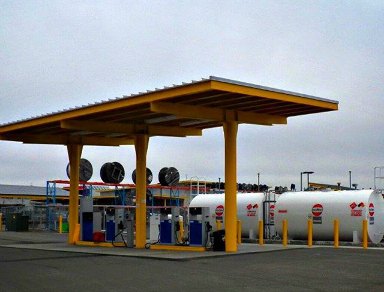Transportation accounts for about one-third of Oregon’s energy use. Alternative fuels like ethanol or biodiesel can increase energy security, reduce
fossil fuel emissions, and cut negative health effects of fossil fuels.

Renewable Natural Gas/Biogas
Some Oregon facilities currently generating biogas simply flare the biogas, while others burn it in a special internal combustion engine that is connected to a generator that produces electricity. Those facilities either consume that electricity on-site or sell it onto the grid through a Power Purchase Agreement with an electric utility. Another option is emerging in Oregon: cleaning up biogas to meet natural gas pipeline quality standards – at which point it is called Renewable Natural Gas (RNG) – and then injecting it into an existing natural gas pipeline. The RNG can be sold as either a direct use stationary fuel or as a transportation fuel.
Oregon recently quantified opportunities to convert persistent, long-term waste streams into useful energy as biogas and RNG. Municipal waste streams — garbage, wastewater, and waste food — and agricultural waste streams like manure, all generate methane, a powerful greenhouse gas. Redirecting these waste streams into controlled processes can capture and use the methane, reducing greenhouse gas emissions and air pollutants when the resulting RNG is substituted for fossil fuels in our transportation and stationary fuels sectors. If Oregon’s potential volume of RNG could be captured and used to displace fossil-based natural gas for stationary combustion, we would prevent the release of approximately two million metric tons of greenhouse gases into the atmosphere. Redirecting this fuel source into these sectors can also potentially result in increased economic opportunity, and provide energy security and resilience for Oregon communities.
Ethanol
Ethanol is a renewable fuel made from various plant materials, primarily
corn. Oregon’s renewable fuel standard requires nearly all gasoline sold to be
a 10 percent ethanol blend.
A higher blend of ethanol – known
as E85 – is also available in Oregon. This fuel must be used in flexible fuel
vehicles, which can run any combination of gasoline and ethanol blends. E85 is
available at five public retail locations in Oregon. Additionally, five fleets use
E85, including the Department of Administrative Services, the Department of
Transportation, the Department of Forestry, the Eugene Water and Electric Board,
and the Veterans Affairs Portland Campus.
Several steps are involved in making ethanol available as a vehicle fuel:
- Feedstocks are grown, collected, and transported to an
ethanol production facility.
- Ethanol is made from these feedstocks at a production facility along
with byproducts such as animal feed and corn oil. The fuel is then
transported to a blender/fuel supplier.
- Ethanol is mixed with gasoline by the blender/fuel supplier and
distributed to fueling stations.
We expect non-edible plant
material, rather than corn, will become the dominant source of ethanol in the
future. This “cellulosic” material cannot be used as food, so it wouldn’t
reduce edible resources.
Biodiesel
Biodiesel is produced from
a diverse mix of feedstocks including recycled cooking oil, agricultural oils,
and animal fats. The state renewable fuel standard requires five percent of
diesel consumed in state must be biodiesel.
Oregon-based biodiesel
company SeQuential produces most of its fuel from used cooking oil collected
from restaurants and food processors around the region. SeQuential sells its fuel at more than 60 locations in the state.
Several fleets such as the Oregon Department of Forestry, the Oregon Department of Transportation, the Eugene Water and Electric Board, Organically
Grown, and the City of Portland use high blends of biodiesel in their fleets.
Renewable Diesel
Hydrogenation-derived renewable diesel is made from fats or vegetable
oils – alone or blended with petroleum – refined by a process called hydrotreating.
This fuel is cleaner and has a lower carbon footprint than petroleum-based
diesel, and it can also operate at colder temperatures than standard diesel or
biodiesel.
Several fleets in Oregon use renewable diesel, though most of the renewable
diesel is imported and only available in limited quantities.